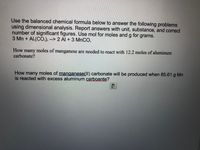
Chemistry
10th Edition
ISBN: 9781305957404
Author: Steven S. Zumdahl, Susan A. Zumdahl, Donald J. DeCoste
Publisher: Cengage Learning
expand_more
expand_more
format_list_bulleted
Concept explainers
Question

Transcribed Image Text:Use the balanced chemical formula below to answer the following problems
using dimensional analysis. Report answers with unit, substance, and correct
number of significant figures. Use mol for moles and g for grams.
3 Mn + Al:(CO.), --> 2 Al + 3 MNCO,
How many moles of manganese are needed to react with 12.2 moles of aluminum
carbonate?
How many moles of manganese(Il) carbonate will be produced when 85.61 g Mn
is reacted with excess aluminum carboante?
Expert Solution
This question has been solved!
Explore an expertly crafted, step-by-step solution for a thorough understanding of key concepts.
This is a popular solution
Trending nowThis is a popular solution!
Step by stepSolved in 2 steps with 2 images

Knowledge Booster
Learn more about
Need a deep-dive on the concept behind this application? Look no further. Learn more about this topic, chemistry and related others by exploring similar questions and additional content below.Similar questions
- Using the equation below, find how many grams of tin (Sn) can be produced from 13.32 g of H2. Round to the nearest 0.01 and remember to include both units and substance. SnO2 + H2 --> Sn + H2Oarrow_forwardIn parentheses you will see that the products is not balanced .*first we will have to balance the products . Pls Help and write neatly so I can understand thank you!!!arrow_forwardQ.1: If 42.1 g of C4H10 0 react with 73.0 g of 02 according to the reaction Equation : C4H10 0 + 02 CO2 + H20 a) Write the balanced equation for the reaction. b) Determine the moles of given reactants b) Find the limiting reagent, c) calculate the mass of CO2 formed, d) If the actual yield of CO2 is 55.8 g, what is the percent yield? Given that: C= 12 g/ mol. , 0 = 16 g/ mol., : H = 1 g/ mol.arrow_forward
- Consider the stoichiometry of the reaction provided in the question(s) below. a. A laboratory student started with 0.0812 grams of Reactant A (benzaldehyde, m.w. 106.12 g/mol). How many millimoles of Reactant A did the student add to the reaction mixture? b. A laboratory student started with 0.162 grams of Reactant B (sodium chromate, m.w. 161.97 g/mol). How many millimoles of reactant B did the students add to the reaction mixture? c. Which of the reactants is the limiting reagent? d. After running the reaction, the student isolated 0.0733 grams of signal product (benzoic acid, m.w. 122.12 g/mol). How many millimoles pf product did the student isolate? e. calculate the % yield of this reactionarrow_forwardIm stuck on the last three questionsarrow_forwardUse the References to access important values if needed for this question. For the following reaction. 5.63 grams of iron(III) oxide are mixed with excess aluminum. The reaction yields 2.88 grams of aluminum oxide. Fe₂O₂ (s) + 2Al(s) Al₂O, (s) 2Fe (s) (1) What is the theoretical yield of aluminum oxide? (2) What is the percent yield for this reaction? % gramsarrow_forward
- fill in blanks and solve using the emthod shown! pleasearrow_forwardQ.1: If 42.1 g of C4H10 0 react with 73.0 g of 02 according to the reaction Equation : C4H10 0 + 02 CO2 + H20 a) Write the balanced equation for the reaction. b) Determine the moles of given reactants b) Find the limiting reagent, c) calculate the mass of C02 formed, d) If the actual yield of CO2 is 55.8 g, what is the percent yield? Given that: C= 12 g/ mol. , O = 16 g/ mol., : H = 1 g/ mol.arrow_forward
arrow_back_ios
arrow_forward_ios
Recommended textbooks for you
 ChemistryChemistryISBN:9781305957404Author:Steven S. Zumdahl, Susan A. Zumdahl, Donald J. DeCostePublisher:Cengage Learning
ChemistryChemistryISBN:9781305957404Author:Steven S. Zumdahl, Susan A. Zumdahl, Donald J. DeCostePublisher:Cengage Learning ChemistryChemistryISBN:9781259911156Author:Raymond Chang Dr., Jason Overby ProfessorPublisher:McGraw-Hill Education
ChemistryChemistryISBN:9781259911156Author:Raymond Chang Dr., Jason Overby ProfessorPublisher:McGraw-Hill Education Principles of Instrumental AnalysisChemistryISBN:9781305577213Author:Douglas A. Skoog, F. James Holler, Stanley R. CrouchPublisher:Cengage Learning
Principles of Instrumental AnalysisChemistryISBN:9781305577213Author:Douglas A. Skoog, F. James Holler, Stanley R. CrouchPublisher:Cengage Learning Organic ChemistryChemistryISBN:9780078021558Author:Janice Gorzynski Smith Dr.Publisher:McGraw-Hill Education
Organic ChemistryChemistryISBN:9780078021558Author:Janice Gorzynski Smith Dr.Publisher:McGraw-Hill Education Chemistry: Principles and ReactionsChemistryISBN:9781305079373Author:William L. Masterton, Cecile N. HurleyPublisher:Cengage Learning
Chemistry: Principles and ReactionsChemistryISBN:9781305079373Author:William L. Masterton, Cecile N. HurleyPublisher:Cengage Learning Elementary Principles of Chemical Processes, Bind...ChemistryISBN:9781118431221Author:Richard M. Felder, Ronald W. Rousseau, Lisa G. BullardPublisher:WILEY
Elementary Principles of Chemical Processes, Bind...ChemistryISBN:9781118431221Author:Richard M. Felder, Ronald W. Rousseau, Lisa G. BullardPublisher:WILEY

Chemistry
Chemistry
ISBN:9781305957404
Author:Steven S. Zumdahl, Susan A. Zumdahl, Donald J. DeCoste
Publisher:Cengage Learning

Chemistry
Chemistry
ISBN:9781259911156
Author:Raymond Chang Dr., Jason Overby Professor
Publisher:McGraw-Hill Education

Principles of Instrumental Analysis
Chemistry
ISBN:9781305577213
Author:Douglas A. Skoog, F. James Holler, Stanley R. Crouch
Publisher:Cengage Learning

Organic Chemistry
Chemistry
ISBN:9780078021558
Author:Janice Gorzynski Smith Dr.
Publisher:McGraw-Hill Education

Chemistry: Principles and Reactions
Chemistry
ISBN:9781305079373
Author:William L. Masterton, Cecile N. Hurley
Publisher:Cengage Learning

Elementary Principles of Chemical Processes, Bind...
Chemistry
ISBN:9781118431221
Author:Richard M. Felder, Ronald W. Rousseau, Lisa G. Bullard
Publisher:WILEY